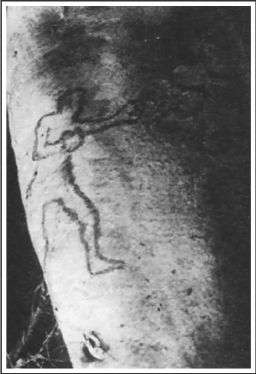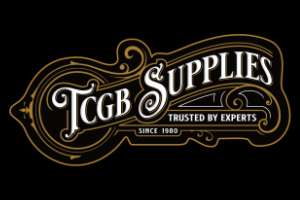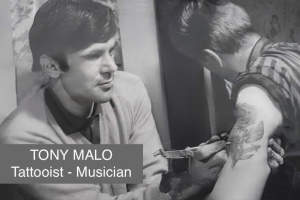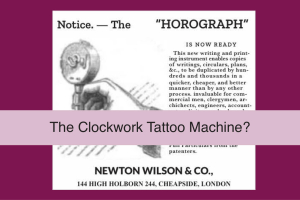
Tattooing and the Chilling Mystery of Severed Limbs
A Shocking Discovery and the Infamous Shark Arm Case
Tattooing has over the years weathered many a storm – and with anything popular there is also a down side – And the following article is one that featured in our club magazine in 2002 – telling of a couple of crimes where the indelible mark has played a part.
One man who could tell us so much more on the health and crime side of things is Doctor Kris Sperry MD, (1954-) a guy who has written many articles for the National Tattoo club newsletter in America – and various other tattooing publications over the years.
I mention Dr Sperry because of the fact that on one fine February morning in 2002 – I was happily sitting in bed masticating on a ginger nut – When I decided to turn on the television and low and behold there was the good doc himself – talking on the BBC news about the hundreds of dead bodies that had been turning up at the Tri-state crematory in South Chattanooga, Tennessee – And as I watched the news – it soon transpired that a woman walking her dog near to the crematory came across an unburied human skull and after alerting police who raided the property – soon discovered to their horror – hundreds upon hundreds of dead bodies piled high into sheds, lock ups and buried in woods around the area.
At first it looked like the police had come across the scene of some incredible mass murder sight – but thankfully no such crime had taken place – as it turned out that the 334 bodies that were found – were the bodies of people who had died and should have been cremated.
It also came to light that many of the corpses had been stacked on top of each other since the early 1990’s – and the crematory’s owner operator ‘Ray Marse’ claimed that he couldn’t cremate the bodies as his ovens had stopped working and he could not have them repaired through lack of money – Which was not true as the ovens were fully functional when the authorities switched them back on.
Two hundred bodies have never been identified and Dr Kris Sperry spoke in his capacity as Georgia’s chief medical examiner – Ray Marse was arrested on three hundred felony charges – five of theft by deception (he took payments for cremations he did not perform) and seven hundred and eighty seven (787) criminal counts by the state of Georgia – of which he is now serving a twelve year prison term with seventy five years probation – The strange thing about this case is that it would have been much easier for Marse to have cremated the bodies – then to have gone to all the trouble he did in trying to hide them.
I mention Kris Sperry and his work on the crime front, because of the happenings that have been going on down in Australia – with the breaking news (18th March 2002) that in the Hawkesbury River, North-West Sydney two young fisherman got the catch of their lives when they pulled from the river a heavily tattooed arm.
A second arm was found the next day – near enough to the same site – and on the third day after a police search – a severed head was also discovered. Police superintendent Tony Mcwhirter said that the arms belonged to 32-year-old David Sutton (no fixed address) but as yet the head had not identified as Sutton’s.
And it was the discovery at the Hawkesbury River that helped me recall another true story involving a slimier history that started on the 18th April 1935 – when a Bert Hobson who was sea-fishing off the Coogee Beach Sydney – caught not one but two sharks. The smaller shark that had taken the bait was now the bait itself and being devoured by the (second) much bigger 4.3 metre creature.
Hudson being the entrepreneur he was – knew exactly what he could do with his catch to make some money – and that was to take the shark to his brother Charlie – who owned an Aquarium in Coogee – and with Anzac Day weekend approaching – he knew the shark would help to draw in the customers – To which it did – with large crowds paying to have a look at the monster.
But to the audience’s disappointment the shark didn’t seem to move around too much – until that is – when it started to thrash about before vomiting a complete human arm – much to the horror of the paying public – and with this – the ‘Shark Arm Case’ had began.
The arm which was tattooed with the design of a prize fighter and as well as the fact that the police could take fingerprints from the hand – enabled them to find that the arm belonged to a small time villain called Jimmy Smith – a man known locally as a suspected drug smuggler and fraudster.
Many theories followed – and after a pains taking investigation – the New South Wales police force came to the conclusion that Smith may have been blackmailing his former gangland boss Reginald Holmes – who the police later believed had arranged for a Patrick Brady to murder the blackmailer – and that Smith’s arm was cut off to show that Brady had indeed done his job before it was thrown into the sea.
Brady was arrested and charged with murder, based on information coming from Holme’s himself – But on the day of the inquest into Smith’s death (1am on the 12th of June 1935) Reginald Holmes was found shot dead at Dawes Point near the Harbour Bridge, Sydney.
This act almost certainly saved Brady’s neck – as the case with its star witness gone looked lost from the start – and indeed Brady was acquitted when Justice Halse Rogers of the New South Wales Supreme Court ruled an arm didn’t constitute a murder and that Smith could still be alive somewhere.
Brady who lived a life of crime (in and out of jail up to his death in 1965) took his secret (if he did do it) to his grave. Jimmy Smiths body was never found dead or alive and the shark arm case in Australia remains unsolved to this day.
Another case also unsolved and again with similarities to the Hawkesbury River and the shark arm case regarding severed limbs and tattooing was the 1935 to 1942 Torso murders of the Kingsbury Run area in Cleveland, Ohio of the USA – which not only led to one of the biggest manhunts in American crime history – it also helped to bring about the shocking downfall of one the counties top crime-fighters Eliot Ness (1903-1957).
Who in 1934 came to clean up the streets in his capacity as the newly appointed director of public safety, and who at the young age of 32 had plenty to look forward to – he had with the help of his “Untouchables” already cleaned up Chicago and Al Capone’s bootlegging (alcohol) empire – so the future was looking good. All except for a maniac as elusive as London’s Jack the Ripper had been some 47 years before – and if the Ripper was the world’s first serial killer then it’s quite fair to say that Cleveland’s torso murderer was one of the first in America history.
But what has this all to do with tattooing? – Well the Torso murderer who was also called the mad butcher and the Head Hunter by the local newspapers because of his (or her’s) love of dismembering the 12 men and women that were killed – and was suspected of killing up to at least 40 others – Forth victim was tattooed and was thought to have been an hobo – as the Kingsbury Run area was a valley and a desolate waste land at the time of the great depression – attracting the dregs, outcasts and the homeless of society – drawing people to the near by yards of the railroad’s boxcars that would enable many to hop on and get away from the cruel Cleveland winters – if they could get past the rail detectives known as “Bulls” that was – who were notorious in their treatment of the down and outs when they caught them.
This is why the Cleveland police department thought that victim no.4 was a vagabond having been discovered close to the Kinsman Road Bridge that passed over the Run – Or to be more to the point where the man’s severed head was found under a bush by two boys – with the body being stumbled upon beside the office of the Nickel Plate Railroad Police some nine hours later.
The victim was nearly 6ft tall – 155 pounds, had brown hair and blue eyes, was well nourished and although naked – clothes that were found 15 feet away from the head appeared to be new. A little later at the Cuyahoga County morgue the body was reunited with it’s head, and the coroners report told of the five missing teeth and the six tattoos that this man had – and was hoped that they would help to identify him. The tattoos were the initials WCG left forearm, crossed flags right forearm, the names Helen – Paul above a bird, right shoulder, a butterfly left calf, cartoon character Jiggs right calf and a cupid over an anchor also on the calf. Death came to this young man in the same way as the madman’s other victims – decapitated while still alive – His body was also washed clean and drained of blood – which would have been an impossible act to perform in the Kingsbury Run with the amount of people who would come and go in the area at any given time – day or night – and as there wasn’t any blood under the body he must have been killed elsewhere (as in the Black Dahlia case later).
The tattoos were believed to be the biggest clues and it was thought that because of them he might have been a sailor – And a team of police officers visited tattooing parlours and various other hangouts throughout Cleveland in the hope – that because of the unique tattoos the man had – someone would know who the John Doe was – His body was even put on display to be viewed by the public in the hope of finding out who he was – and it was recorded that up to two thousand people viewed the body and the death mask that had been made of him on that first night in 1936 alone – with thousands more visiting the city morgue thereafter – Victim no.4 became famously known as ‘The Tattooed Man’ but like the killer his identity remained a mystery.
Eliot Ness who in his time in Cleveland did indeed see progress in the cleaning up of the cities bootleggers (shutting down a still a day) and sorting out police corruption, but critics like wolves descended on Ness for the failure to bring in the Torso murderer.
In 1936 Ness realised that a great opportunity would open up for him when he was asked to design the Cleveland police display unit at ‘The Great Lakes Exposition’ (which started June and ran for 100 days) – This he undertook and included the death mask of ‘The Tattooed man’ but to no avail – as even-though 4 million people visited the show which was a combination of super amusement park and world fair with displays featuring some of the countries top celebrities of the 1930’s – no one came forward with any information about the dead man – The next year (1937) the exposition was put on again – and the Cleveland police were once more on hand with photographs of victim no.4 to show as many of the 3 million visitors who attended – which again drew a blank.
Eliot Ness did put two of his top detectives Peter Merylo and Martin Zalewski – on the case full time but Ness himself said little in regards to the murderer, only talking of it in dispatches some twenty years later – when he said he believed that the real killer was a Doctor Francis E Sweeney – A man who had failed two lie detector (polygraph) tests about his involvement in the crimes – and was a known schizophrenic and drunk with a terrible temper and who was often found wandering in the Kingsbury run area and knew the place very well – But alas for Ness and his team they couldn’t find enough evidence to bring the doctor to trial.
Merylo through the torso slayings visited other murder sites across the country in the hope of catching the madman – and two such other sets of murders resembled Cleveland’s. The first being the three decomposed bodies that were discovered at Mckees Rocks, Pennsylvania in May of 1940. Where one had the word NAZI carved into his chest and all three were dismembered in the same way as the Head Hunters.
Merylo also went to Los Angeles in 1947 after Elizabeth Ann Short’s butchered body was found on a vacant lot on South Norton Avenue, where he and other lawman found many similarities to Short’s and six of the Cleveland killings – that being in the cutting and carvings on the bodies.
Elizabeth Shorts body was found horribly mutilated on the vacant lot at 10.30am on the morning of Wednesday the 15th of January 1947 by a Mrs Betty Bersinger who was out walking with her child – and her first thought was that she had come across a stores disregarded fashion mannequin – Until upon further inspection she found she was looking down on a young woman who had been completely cut in half.
A team of homicide detectives led by Sergeants Finnis Brown and Harry Hansen of the Los Angeles Police department were soon at the scene (police officers Frank Perkins and Will Fitzgerald was first to arrive) – to discover that not only had the body been severed in two pieces – the face had been badly beaten and viciously cut – rope marks on her wrists and ankles – and the victims torso was covered in what looked like cigarette burns and small cuts – There was also no sign of blood proving that the body was killed elsewhere before being dumped.
It was when fingerprints were taken at the Los Angeles County Morgue it became apparent that the body was that of a Miss Elizabeth Ann Short (1924-1947) known locally as Beth Short (her fingerprints had been on file since 1943 when she was arrested for juvenile delinquency) – The coroner also found that the initials BD had been cut into her right inner thigh – which stood for ‘Black Dahlia’ the name in which Elizabeth Short also became known – Her mouth and stomach contained excrement (of which she must have been forced to eat) and that there was also a small amount of grass and a piece of skin that was tattooed with a rose design – pushed well up into her vagina – The skin having been cut from her left thigh.
Forensics also found that the victim had been tortured for up to three days beforehand – and that the cuts on her body were performed with a small bladed knife that did not cut deep enough to kill – Her legs had also been broken with a smoothly rounded instrument possibly a baseball bat and she had been hung upside down for a while before death – which was around ten hours before she was found – The killer also went to the trouble of draining the body of blood – scrubbing it clean and shampooing her hair.
Over forty confessing Sam’s (American police slang for someone who confesses to a crime they didn’t commit) have come forward over the years to say they did the killing – but none of them knew any of the facts that the police didn’t make public about the case – so were disregarded as suspects – But the LAPD did receive a couple of letters from the killer – which were little more then taunting them – before a parcel that contained items that belonged to Elizabeth Short arrived in the post – which sadly didn’t contain anything that would lead to the killers identity.
The Black Dahlia one would presume got her nickname because of her love in wearing black clothing – but it could have came via the Veronica Lake (1919-1973) Alan Ladd (1913-1964) movie that was doing the rounds in cinemas across the US at the time entitled ‘The Blue Dahlia’ (1946).
As a footnote – Before her death Elizabeth Ann Short was thought to have had some limited success as a bit part actress – But soon found that the murkier sinister underbelly of society was a somewhat easier trap to fall into – And the sad part of Elizabeth Short’s short life is that all she really wanted to be was a player and be famous just like the thousands of other beautiful young things that travel to California every year from all over the planet – in the hope of becoming Hollywood movie stars – Something sadly only the very lucky few ever achieve.
Homicide detective Harry Hansen remained on the case of the Black Dahlia until he retired from the LAPD in 1971 – and later worked as the technical director on the 1975 television movie (100 min) ‘Who Is The Black Dahlia’ – A film that is just one of the many that has hit the cinema screens since the murder – There has also been hundreds of articles and many books written on this grisly unsolved American crime – So in a way Beth Short did gain the sort of fame she so sought in life – albeit in the most horrid and morbid way.
In 2006 two more feature films about the case have been released – one entitled ‘Black Dahlia’ – which is believed to have gone straight to DVD and the other a major motion movie from ‘Universal Pictures’ – that had a budget of some $40 million dollars and a cast with some of Hollywood’s finest young stars – including (among others) Josh Hartnett (1978-) – Scarlett Johansson (1984-) – Aaron Eckhart (1968-) – Hilary Swank (1974-) and Mia Kirshner (1975-) who played Elizabeth Short herself – This film being based on the 1987 fictionalized treatment (novel) from James Ellory (1948-) – and described by some as true crime meets urban legend.
This movie had its world premier at the 2006 – 63rd Venice Film Festival on the 30th of August and was directed by Brian De Palma (1940-).
And getting back to Eliot Ness if anybody is still interested – he left his post as director of public safety after a hit and run incident in 1941 in which Ness was involved following a night of drinking with his wife and friends at the Hollenden Hotel. And although no charges were issued against him the damage was done – and the accident had an irreversible effect on his popularity with the public.
He did stand as the republican candidate for Mayor of Cleveland in 1946 but lost out to democrat Thomas A. Burke to the tune of 168,412 votes to 85,990 and this just like the Torso Murders was something that he never seemed to get over.
Three times married Eliot Ness died in 1957 aged 54 – from a massive heart attack – ten thousand dollars in debt with no real estate or savings to his name – There was no mention of Ness’s passing in any of the Chicago newspapers of the day.
Copyright…Paul Sayce.
Posted on 21st May 2010






